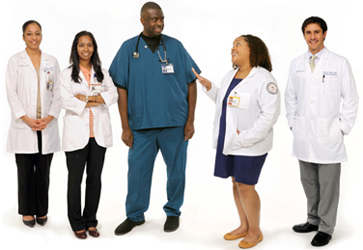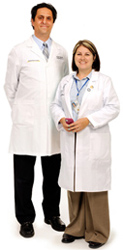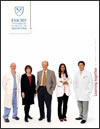Engaging hearts and minds
See captions below.
|
In this report
1. At 2013 graduate Alex Johnson with potential member of the class of 2040 2. Medical and nursing faculty teach medical and nursing students together in simulation labs. 3. While here, Victor Wu (Emory MD, MPH, and residency alumnus) helped the Institute of Medicine develop a literacy tool kit for health insurance. He was recently named a White House fellow. 4. Last spring, the class of 2013, the largest in Emory’s history, had one of the school’s best residency matches ever. |
Emory has long been cognizant of the need to assess medical school applicants’ understanding of social and behavioral sciences—factors soon to be assessed in the standard medical school entrance exam.
Factors such as cultural awareness and communication skills are increasingly important. Preparing students for 21st century medicine means teaching them to work in highly functioning clinical teams while modeling (and measuring) role delineation, personal responsibility, and empathy.
Team-based care at the bedside
 The most powerful learning comes not from books or lectures, says hospitalist Jason Stein, but from what students see their mentors do. Thanks to a new bedside rounding model designed by Stein and his colleagues, what medical students and residents see in Emory’s hospital units is clinical teamwork and learning together in action. In structured interdisciplinary bedside rounds, or SIBR (pronounced “cyber”), the unit’s Section 2bedside physicians, residents, nurses, social worker, and pharmacist go together as a group from room to room each morning to discuss each patient’s progress with the patient and patient’s family. Everyone on the care team and the patient and family hear the same report and can update the care plan together.
The most powerful learning comes not from books or lectures, says hospitalist Jason Stein, but from what students see their mentors do. Thanks to a new bedside rounding model designed by Stein and his colleagues, what medical students and residents see in Emory’s hospital units is clinical teamwork and learning together in action. In structured interdisciplinary bedside rounds, or SIBR (pronounced “cyber”), the unit’s Section 2bedside physicians, residents, nurses, social worker, and pharmacist go together as a group from room to room each morning to discuss each patient’s progress with the patient and patient’s family. Everyone on the care team and the patient and family hear the same report and can update the care plan together.
The physician talks with the patient (sitting at eye level, no jargon please), and the care team listens in. They address patient and family concerns, cross-check each other on the patient’s progress, and review a quality-safety checklist. SIBR leads to better coordination of care and strengthens the safety net for patients. It has been well received by clinicians and patients and has been shown to reduce hospital mortality, length of stay, and nursing turnover. It also illustrates for students a shared model for how and what to communicate.
Quantifying effectiveness of teaching and learning
The medical school recently implemented three new areas of measurement to help ensure that teaching goals are on track. First, how well is the school doing in accepting the kind of students who will work best with patients—those with skills not only in science but also in working and communicating with people?
 Second, is the learning environment a positive one (a measurement now required by the LCME, the accrediting body for medical schools)? That is, do students observe their faculty demonstrating respect and cooperation among colleagues, or are there some aspects that require changing? Does the environment encourage empathy and minimize burnout or depression, and if these occur are there mechanisms in place to recognize and address them?
Second, is the learning environment a positive one (a measurement now required by the LCME, the accrediting body for medical schools)? That is, do students observe their faculty demonstrating respect and cooperation among colleagues, or are there some aspects that require changing? Does the environment encourage empathy and minimize burnout or depression, and if these occur are there mechanisms in place to recognize and address them?
And third, do members on teams have a clear understanding of their individual roles and personal responsibilities rather than relying on the collectivity of the team to make sure nothing falls though the cracks?
Sharing wisdom, dispelling stereotypes
Seniors in the community are teaming up with medical, nursing, and physician assistant students early in their training, giving them an intimate, year-long look into the daily lives of senior adults outside the hospital or clinical setting. The experience gives students a chance to practice communication skills, discussing sensitive health and personal information, and to see in practice how the health of older people is strongly related to the communities where they live. The senior mentoring program is a project of the Atlanta Regional Geriatric Education Center, a partnership among Emory, Morehouse School of Medicine, Georgia State University, and the Atlanta Regional Commission.

